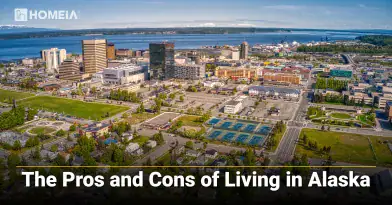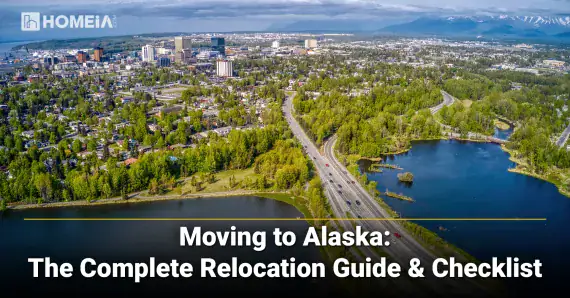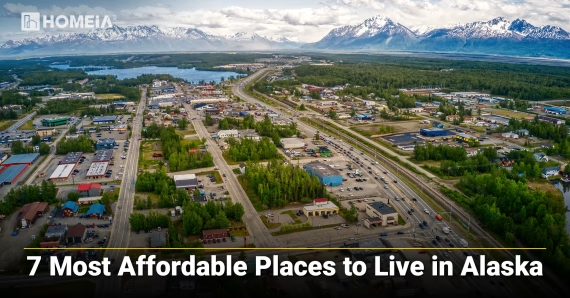The 5 Best Places to Live in Alaska: A City Comparison
- Local Editor:Local Editor: The HOMEiA Team
Published: Oct 25, 2025
- Category: City Living Guide

Alaska is a state of stunning contrasts, where rugged wilderness coexists with modern innovation and frontier spirit borders vibrant urban centers. Choosing the right community within The Last Frontier is crucial to unlocking a lifestyle fitting your ambitions, no matter the goal.
This guide provides an in-depth, data-driven analysis of the state’s five best places to live in 2025. We’ve dug deep to evaluate these population centers on the factors that matter most: economic opportunity, affordability, safety, access to amenities, and unique quality of life. From the high-energy vibe of Anchorage to the serene island majesty of Sitka, we break down what makes each city a premier destination for building your future in the Great Land.
For those considering other states, you might also explore our comparison of the pros and cons of living in Washington State.
Table of Contents:
Key Takeaways
Diverse Options for Diverse Needs: These top cities offer distinctly different lifestyles, from the urban economic engine of Anchorage to the tight-knit, high-performing community of Sitka.
Cost of Living is a Reality: A major consideration across all five cities is the cost of living above the national average, with housing costs reflecting Alaska’s unique logistical challenges.
Safety Varies Significantly: Safety ratings range from excellent to moderate, making it crucial to research specific neighborhoods and cities based on your personal tolerance and priorities.
Economic Drivers Differ: Each city’s job market is anchored by a different sector—government, fishing, military, tourism, or technology—requiring alignment with your career field.
Culture is Key: The intangible sense of place, community, and access to wilderness and culture are often the defining factors in choosing between these exceptional locations.
I. Methodology: How We Chose the Best
Our Methodologies to create HOMEiA Score Ratings for Each Group of Content
HOMEiA uses a consistent, data-driven methodology to evaluate U.S. states for livability, affordability, and long-term value. Drawing on data from sources such as the Census Bureau, BLS, Zillow, the Tax Foundation, and FBI crime statistics, this approach supports rankings on cost of living, relocation planning, pros and cons, and best places to live.
II. The 5 Best Cities: A Portrait of Alaska’s Diversity
1. Fairbanks: The Interior Heartland
HOMEiA Score: 82/100
- Cost of Living: 10% above U.S. average
- Monthly Rent: $1,350
- Home price to income ratio: 5.2:1
- Income to rent ratio: 51.9x
- Safety rating: 68/100
A. Employment & Economy: Fairbanks is defined as the economic and cultural hub of Interior Alaska, with major employers including the University of Alaska Fairbanks, Fort Wainwright Army Base, Eielson Air Force Base, and the healthcare sector. Benefitting from stable government and military employment provides economic resilience through seasonal variations.
B. Housing & Affordability: Housing options are more affordable housing than Anchorage, with a cost of living 10% above the national average. Everything from historic downtown homes to modern subdivisions are available. The home-price-to-income ratio of 5.2:1 reflects the balance between moderate housing costs and solid local incomes.
C. Quality of Life & Culture: Life is defined by extreme seasons and incredible natural phenomena. Residents cherish spectacular northern lights viewing, midnight sun in summer, and world-class dog mushing culture. UAF hosts cultural events, Division I athletics, and educational opportunities to this frontier city.
D. Access & Infrastructure: Fairbanks International Airport (FIA) provides connectivity throughout Alaska and to the Lower 48. The city serves as the terminus of the Alaska Railroad and the hub of the Interior road system. Modern healthcare facilities and reliable utilities make it one of Alaska’s most livable remote cities.
E. Safety & Community: With a safety rating of 68/100, it’s modest for its size. The community is tight-knit and resilient, with strong ties to the military and university populations. Lengthy, pitch–black winters foster indoor community activities and togetherness.
Moving to Alaska: The Complete Relocation Guide & Checklist.
Alaska, bordered by Canada and the Pacific and Arctic Oceans, offers stunning wilderness and modern living. Home to about 750,000 residents, it blends adventure and independence. With no state income or sales tax, the Northern Lights, and Anchorage’s urban charm, Alaska promises a rewarding frontier lifestyle for new residents.
2. Kodiak: The Emerald Isle
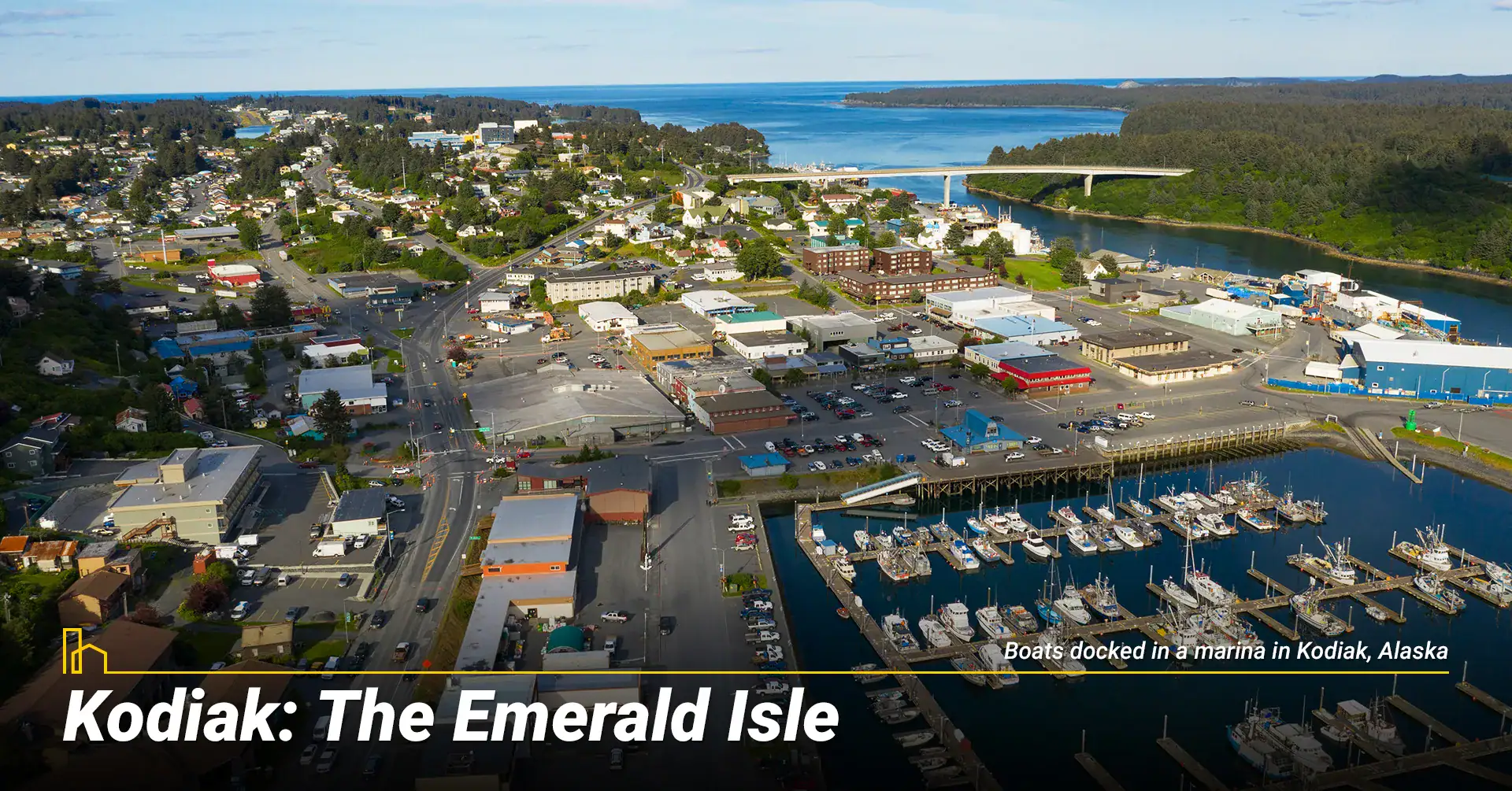
HOMEiA Score: 83/100
- Cost of Living: 28% above U.S. average
- Monthly Rent: $1,550
- Home price to income ratio: 5.5:1
- Income to rent ratio: 58.1x
- Safety rating: 78/100
A. Employment & Economy: Kodiak’s economy revolves around commercial fishing, particularly the lucrative king crab and salmon industries. The Coast Guard base provides stable government employment, while supporting industries including seafood processing and tourism for a resilient economy.
B. Housing & Affordability: Kodiak’s island location drives costs 28% above the national average, but substantial fishing incomes result in a manageable home-price-to-income ratio of 5.5:1. Their housing market offers unique opportunities for waterfront living and access to incredible outdoor resources.
C. Quality of Life & Culture: For those seeking an authentic Alaskan fishing community lifestyle with world-class outdoor recreation, this is the place. Enjoy exceptional bear viewing, fishing, and hiking on the island’s emerald landscapes. The community keeps their lines hooked on fishing traditions and a tight-knit, resilient character.
D. Access & Infrastructure: Being dependent upon regular air service and the Alaska Marine Highway for connectivity, they also have modern healthcare facilities and reliable utilities. Its location in the Gulf of Alaska provides both challenges and incredible natural opportunities.
E. Safety & Community: With a safety rating of 78/100, safety standards are exceptional. The community is known for its resilience, valued fishing heritage, and neighborly support networks. Residents share a deep appreciation of the marine environment and outdoor lifestyle.
3. Juneau: The Capital City

HOMEiA Score: 85/100
- Cost of Living: 25% above U.S. average
- Monthly Rent: $1,800
- Home price to income ratio: 6.1:1
- Income to rent ratio: 41.7x
- Safety rating: 75/100
A. Employment & Economy: As Alaska’s state capital, Juneau’s economy is dominated by stable government jobs. Tourism represents the other major economic pillar, with cruise ships specifically, supporting hospitality, retail, and guiding services. It provides a unique and robust job market largely immune to broader economic swings.
B. Housing & Affordability: Significant housing challenges impact residents due to its island location and limited buildable land. The cost of living is 25% above the national average, with a home-price-to-income ratio of 6.1:1. However, high government salaries make expenses manageable.
C. Quality of Life & Culture: With unparalleled access to wilderness from an urban setting, locals can hike from downtown to glaciers, kayak among whales, and ski pristine slopes. Additionally, the Alaska State Museum, vibrant local arts scene, and Tongass National Forest are cherished activities.
D. Access & Infrastructure: Location presents unique access challenges—it’s the only U.S. state capital inaccessible by road. The city relies on Alaska Airlines for air connections and the Alaska Marine Highway for ferry service. Modern healthcare and utilities make it comfortable despite being remote.
E. Safety & Community: With a safety rating of 75/100, here lies one of Alaska’s safest cities. The community is educated, engaged in civic life, and environmentally conscious. Population blends government workers, long-time residents, and outdoor enthusiasts drawn to the spectacular setting.
Recommended for you
4. Sitka: The Island Paradise
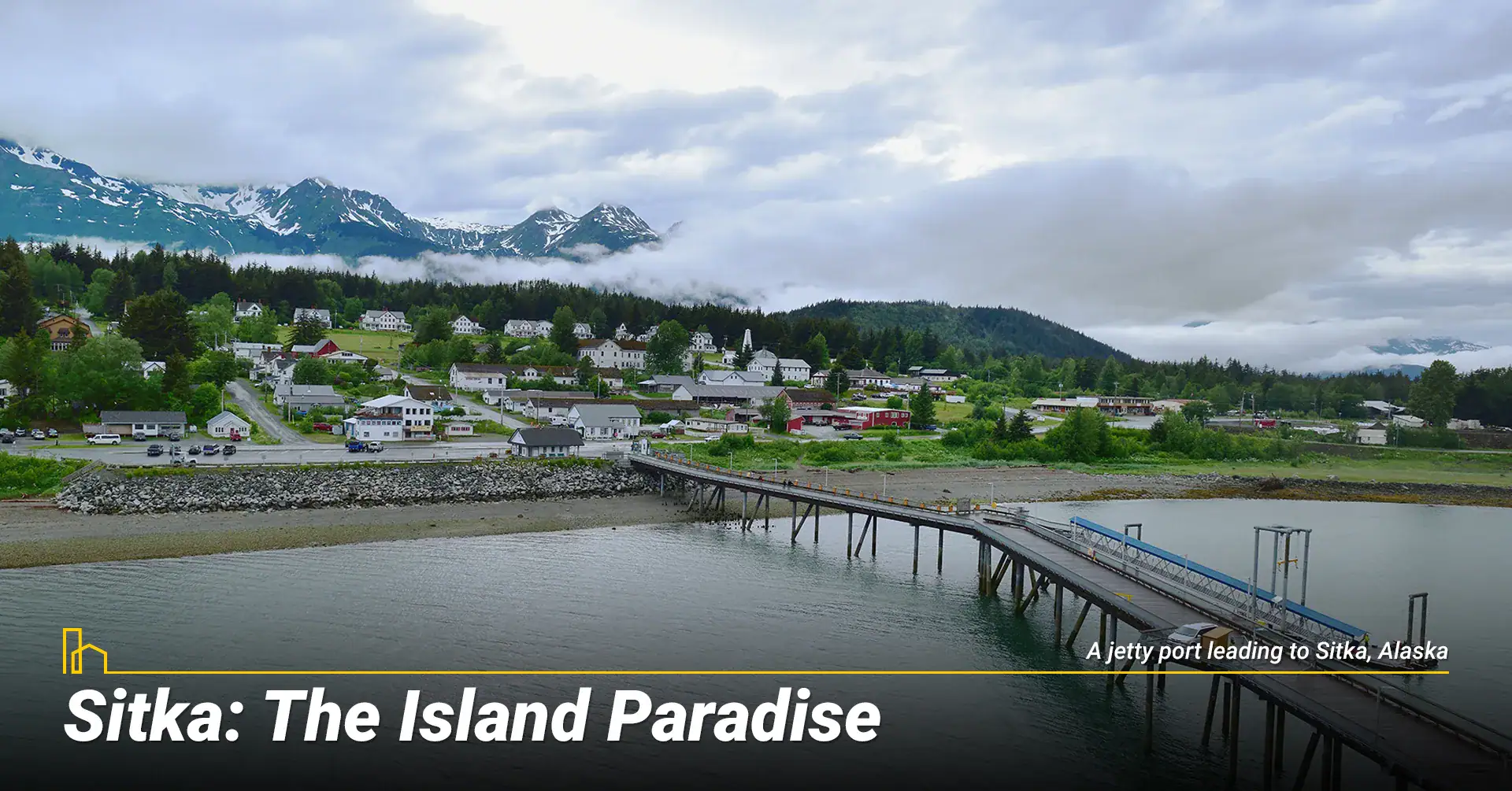
HOMEiA Score: 87/100
- Cost of Living: 30% above U.S. average
- Monthly Rent: $1,600
- Home price to income ratio: 5.8:1
- Income to rent ratio: 56.3x
- Safety rating: 80/100
A. Employment & Economy: Sitka’s economy balances commercial fishing, healthcare, education, and tourism. As home to one of the state’s largest fishing fleets and the Southeast Alaska Regional Health Consortium hospital, the town offers diverse employment opportunities. This combination provides economic stability in a remote setting.
B. Housing & Affordability: Sitka faces high costs due to its island location, with living expenses 30% above the national average. However, the strong local economy results in a reasonable home-price-to-income ratio of 5.8:1. Options include everything from waterfront properties to forested retreats.
C. Quality of Life & Culture: Sitka offers what many consider the storybook Alaskan lifestyle—spectacular natural beauty combined with rich Tlingit and Russian history. Residents enjoy world-class fishing, hiking in Tongass National Forest, and kayaking among islands..
D. Access & Infrastructure: Locals rely on Alaska Airlines for regular air service and the Alaska Marine Highway for ferry connections. The town has modern healthcare facilities through SEARHC and reliable utilities. Its location on Baranof Island provides both isolation and incredible natural access.
E. Safety & Community: With a safety rating of 80/100, Sitka is among Alaska’s safest communities. The town boasts a strong sense of community, excellent schools, and well-maintained properties. Members are highly engaged in local affairs and outdoor recreation.
The Pros and Cons of Living in Alaska
Alaska is known for glaciers, wilderness, and the Northern Lights, but life here also means high costs, harsh winters, and isolation. This guide breaks down the pros and cons of living in The Last Frontier, plus the best cities for young professionals, families, and retirees. Welcome!…
5. Anchorage: The Urban Hub
HOMEiA Score: 88/100
- Cost of Living: 15% above U.S. average
- Monthly Rent: $1,650
- Home price to income ratio: 4.8:1
- Income to rent ratio: 45.5x
- Safety rating: 72/100
A. Employment & Economy: Anchorage is Alaska’s economic engine, serving as the state’s commercial and transportation hub. Diverse industries including oil and gas, transportation, healthcare, military (Joint Base Elmendorf–Richardson), and tourism thrive here. It creates AK’s most robust and diverse job market with opportunities across multiple sectors. The Port of Alaska serves as a vital logistics center for the entire state.
B. Housing & Affordability: Here lies the most diverse housing stock available, from downtown condos to suburban neighborhoods. While the cost of living is 15% above the national average, it remains more affordable than many remote communities. The home-price-to-income ratio of 4.8:1 indicates reasonable purchasing power for residents.
C. Quality of Life & Culture: There exists an “urban meets wilderness” experience found that’s unmatched anywhere else. Within city limits, you can access hundreds of miles of trails, while world-class skiing, fishing, and wildlife viewing are minutes away. The city boasts revered restaurants, cultural institutions like the Anchorage Museum, and serves as the gateway to exploring Alaska’s interior.
D. Access & Infrastructure: As the state’s most connected city, it’s home to Ted Stevens International Airport (ANC), largest hospital (Providence Alaska Medical Center), and comprehensive infrastructure. The city serves as the logistical hub for the entire state, with road connections to the Kenai Peninsula and rail service to Fairbanks and Seward.
E. Safety & Community: With a safety rating of 72/100, you can feel safe overall,with some variation by neighborhood. The community is highly diverse, blending long-time Alaskans, military families, and newcomers. Established neighborhood associations and community organizations provide necessary support networks.
7 Most Affordable Places to Live in Alaska
Despite Alaska’s rugged beauty and higher living costs, several communities offer affordable ways to enjoy the Last Frontier. This guide highlights seven budget-friendly Alaskan towns for 2025, balancing cost, access, and lifestyle. Through data on housing, utilities, and transportation, discover where affordability meets authentic Alaskan living.
Comparative Data Table
City | HOMEiA Score | Cost of Living | Avg. Rent (2-Bed) | Home Price to Income Ratio | Income to Rent Ratio | Safety Rating |
|---|---|---|---|---|---|---|
| Fairbanks | 82 | +10% | $1,350 | 5.2:1 | 51.9x | 68 |
| Kodiak | 83 | +28% | $1,550 | 5.5:1 | 58.1x | 78 |
| Juneau | 85 | +25% | $1,800 | 6.1:1 | 41.7x | 75 |
| Sitka | 87 | +30% | $1,600 | 5.8:1 | 56.3x | 80 |
| Anchorage | 88 | +15% | $1,650 | 4.8:1 | 45.5x | 72 |
Conclusion: Finding Your Perfect Alaska Match
The best Alaskan city depends entirely on your priorities and lifestyle preferences. Anchorage champions urban amenities with wilderness access, while Fairbanks offers authentic interior living with extreme seasons. Juneau provides capital city stability in a spectacular coastal setting, and Sitka offers island paradise with rich cultural heritage. Kodiak is known for authentic fishing community life and world-class outdoor opportunities.
Each location presents unique trade-offs between cost, opportunity, and lifestyle. Your ideal choice hinges on aligning these factors with your personal, financial, and professional goals for life in The Last Frontier. For those still considering options, our guide to the best places to live in Washington State might provide additional insights for Pacific Northwest living.
Recommended for you
FAQs About Living in Alaska’s Best Cities
1. Which city has the best job market? Anchorage has the largest, most diverse job market in Alaska, spanning multiple industries including oil, transportation, healthcare, and military. Juneau offers stable government employment but fewer private sector opportunities outside tourism.
2. I’m a remote worker. Where should I move? For the best blend of reliable infrastructure, amenities, and spectacular setting, Juneau is an excellent choice. For more affordable living with good internet and urban amenities, consider Anchorage. Always confirm internet reliability at your specific address before moving to any Alaskan community.
3. Are these cities safe? Safety is generally excellent across these cities. Sitka ranks highest (80/100), followed by Kodiak (78/100) and Juneau (75/100). Anchorage (72/100) has more urban challenges but maintains good overall safety. Fairbanks (68/100) has good safety standards with some seasonal considerations.
4. What’s the best city for young professionals? Anchorage offers the most vibrant social scenes, networking opportunities, and diverse career paths for young professionals. Juneau provides government career tracks and outdoor recreation in a spectacular setting.
5. What’s the best city for families? Families often choose based on schools and community. Sitka offers excellent schools and highest safety (80/100) in a spectacular island setting. Anchorage provides the most educational options and extracurricular activities while maintaining good safety (72/100).
6. How do I handle the high cost of living? Alaska’s Permanent Fund Dividend provides annual payments to residents, helping offset high costs. Focus on communities with employment matching your skills, and consider that many remote locations offer housing allowances or other compensation. For those considering more affordable mountain states, explore the most affordable places to live in Colorado.
7. What about the long winters? Alaskans embrace winter through outdoor activities like skiing, snow machining, and northern lights viewing. Communities maintain active indoor social calendars, and the spectacular summers more than compensate for winter challenges. Proper preparation and the right mindset make Alaska’s seasons manageable and rewarding.
8. Which city has the best outdoor recreation? All five cities offer exceptional outdoor access, but Sitka and Juneau provide immediate access to both marine and mountain environments. Anchorage offers the most diverse range of organized outdoor activities and facilities, while Kodiak provides unparalleled fishing and bear viewing opportunities.
9. How important is the Permanent Fund Dividend? The PFD provides significant financial support to Alaskan residents, typically ranging from $1,000-$2,000 annually per person. This can substantially offset higher living costs, particularly for families. The dividend is distributed to all eligible residents regardless of income or employment status.
10. What about healthcare access? Anchorage has the most comprehensive healthcare system with specialized medical facilities. Fairbanks and Juneau have regional hospitals with good capabilities. Sitka and Kodiak have modern clinics but may require medevac to Anchorage for specialized care. Always consider your specific healthcare needs when choosing a location.
For those interested in exploring other unique living destinations, you might also consider the best places to live in Montana or discover the pros and cons of living in Wyoming. If you’re drawn to coastal living, our guide to the best places to live in Oregon might provide valuable insights.
HOMEiA is a city guide site where visitors can find detailed information about communities of interest. HOMEiA’s City Guides, created in partnership with local writers and editors, are curated lists of the best, safest, and most affordable places to live. The guides feature the HOMEiA Score, a proprietary index that rates communities on such factors as housing costs, education, employment, etc.
HOMEiA.com aims to be the premier site for people planning to relocate, providing them with insightful content and connecting them with skilled real estate professionals.
We also empower real estate professionals to establish or strengthen their web presence by highlighting their experience, knowledge and achievements. If you’re selected to join our list of certified real estate professionals, you will distinguish yourself from your peers — and earn HOMEiA’s support.
If you believe in HOMEiA’s mission, please share our website with others.







